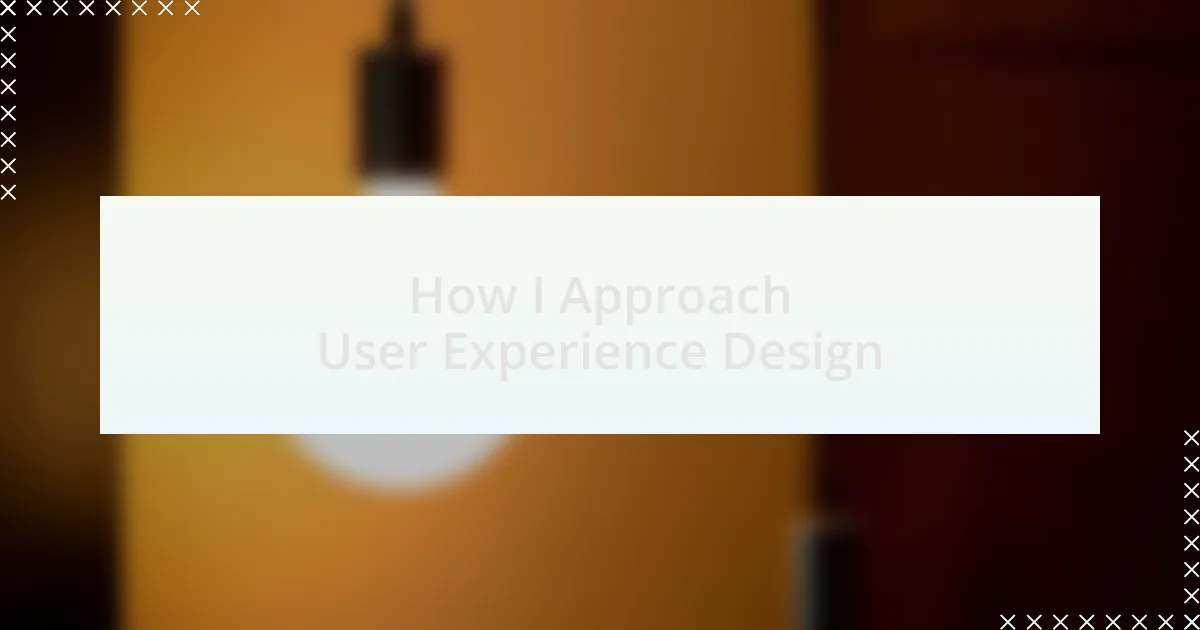Key takeaways:
- UX Design enhances user satisfaction by focusing on usability and accessibility, considering users’ emotional responses during interactions.
- Effective UX design can improve user retention, loyalty, and significantly impact business outcomes, such as increased sales.
- The design process involves deep user engagement, ideation through sketches and wireframes, and iterative usability testing to refine solutions.
Author: Oliver Bancroft
Bio: Oliver Bancroft is an accomplished author and storyteller known for his vivid narratives and intricate character development. With a background in literature and creative writing, Oliver’s work often explores themes of human resilience and the complexities of modern life. His debut novel, “Whispers of the Forgotten,” received critical acclaim and was nominated for several literary awards. In addition to his fiction, Oliver contributes essays and articles to various literary magazines. When he’s not writing, he enjoys hiking and exploring the great outdoors with his dog, Max. Oliver resides in Portland, Oregon.
What is User Experience Design
User Experience (UX) Design is all about enhancing user satisfaction by improving the usability and accessibility of a product. When I first delved into this field, I realized that it’s not just about aesthetics but understanding the user’s journey. How does every click, scroll, or interaction evoke feelings? That’s the essence of UX.
At its core, UX design involves empathy—putting ourselves in the user’s shoes. I remember a project where the feedback highlighted frustration with a complicated navigation system. It struck me how essential it is to create intuitive pathways so users feel guided rather than lost. Can you imagine trying to find information but hitting a wall instead?
Ultimately, UX design is about creating meaningful experiences. It focuses on how users feel when interacting with a site or app. One time, I redesigned a client’s website after countless user interviews and testing phases. The transformation was incredible, and watching their users suddenly engage more was a powerful reminder of the impact good design can have on real people. Isn’t it rewarding to know that our work can genuinely improve someone’s day?
Importance of User Experience Design
User Experience Design is fundamentally important because it shapes how users perceive and interact with a website. I still recall a project where simple, user-friendly adjustments led to a dramatic drop in bounce rates. It was a revelation: when users can easily navigate a site, they’re more likely to stay and explore. Don’t you think we owe it to our users to create environments where they feel comfortable?
The emotional connection users have with a website can dictate their loyalty. In my experience, I redesigned an e-commerce site that was underperforming. By focusing on the user’s emotional journey—making the shopping experience feel seamless—I noticed an increase in repeat customers. Isn’t it fascinating how a smoother user experience can translate to stronger brand attachment?
Moreover, effective UX design can significantly impact a business’s bottom line. I once worked with a startup that saw a 30% increase in sales after implementing user feedback-driven changes. This demonstrated to me that when we prioritize our users, we’re not just creating better experiences; we’re also fostering business growth. Isn’t it inspiring to think that user-centric design can lead to tangible results?
My User Experience Design Process
When I approach user experience design, I begin by immersing myself in the user’s world. In one project, I spent hours interviewing users to understand their needs and frustrations. This firsthand experience taught me that empathy is crucial; once I understood their challenges, it became clear how to tailor the design to meet their expectations. Isn’t it rewarding to feel that connection between user need and design solution?
Next, I sketch out ideas and create wireframes. I remember working on an app where I visualized different user flows on paper, and it was eye-opening to see how slight changes in navigation could enhance the overall experience. Collaborating with my team during this phase often leads to unexpected insights. How often have you noticed that brainstorming can unlock hidden potential in an idea?
Finally, I conduct usability testing to validate my designs. I once facilitated a testing session for a website, and the user’s feedback was enlightening—it revealed pain points I hadn’t considered. It reinforced my belief that the design process is iterative; each cycle of testing and refining brings the project closer to meeting user needs. Doesn’t it feel satisfying to see a design evolve into a solution that truly resonates with its audience?

Leave a Reply